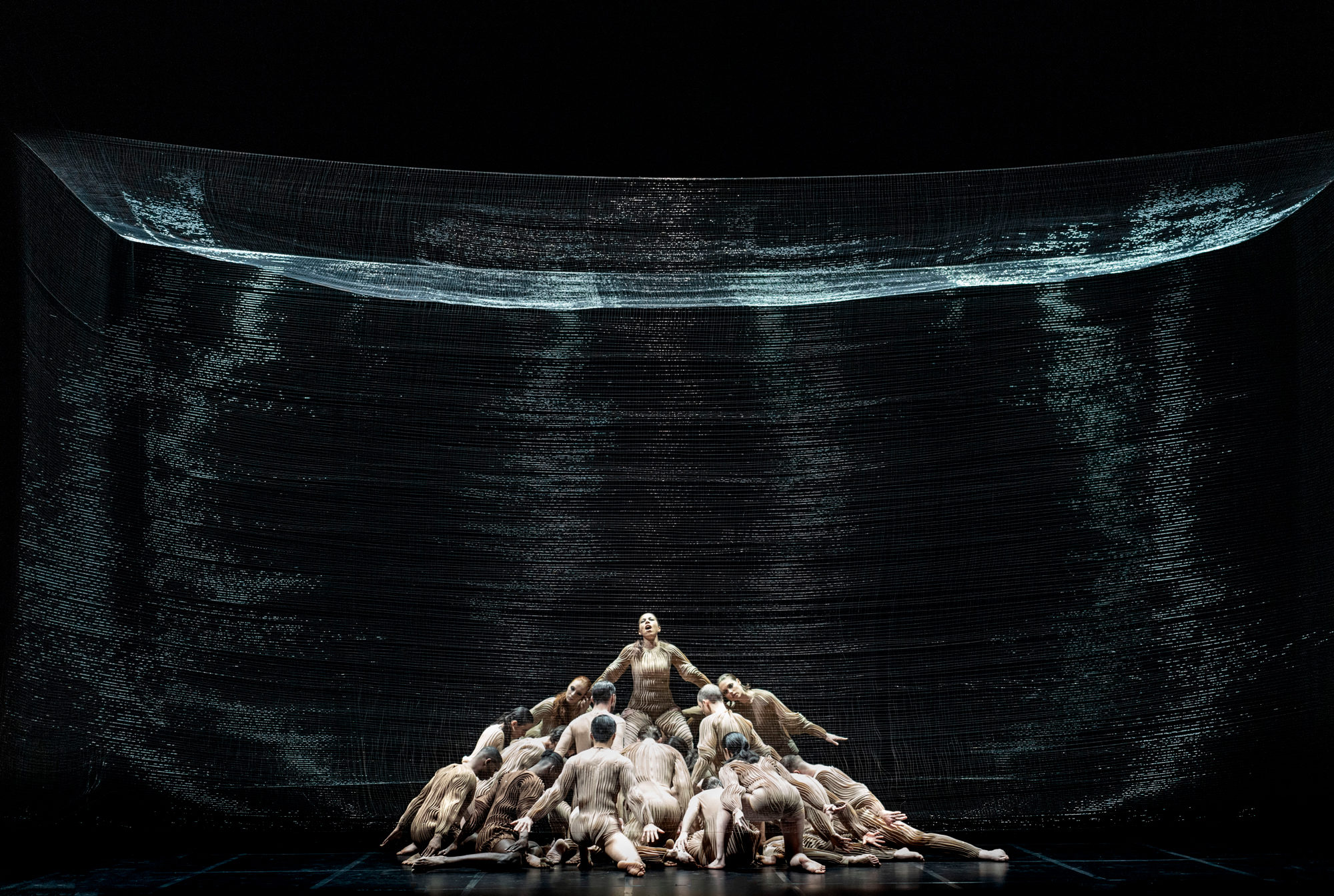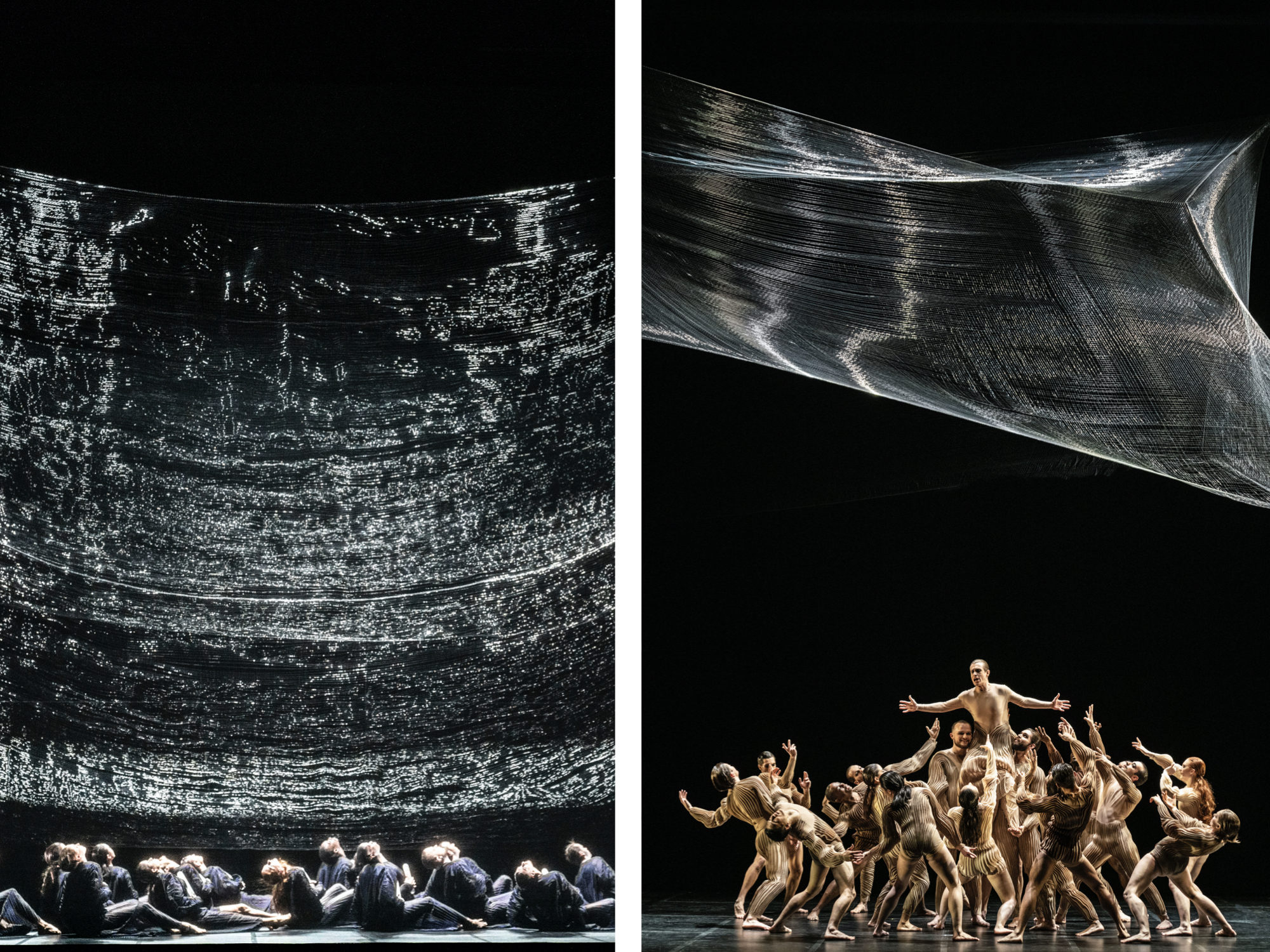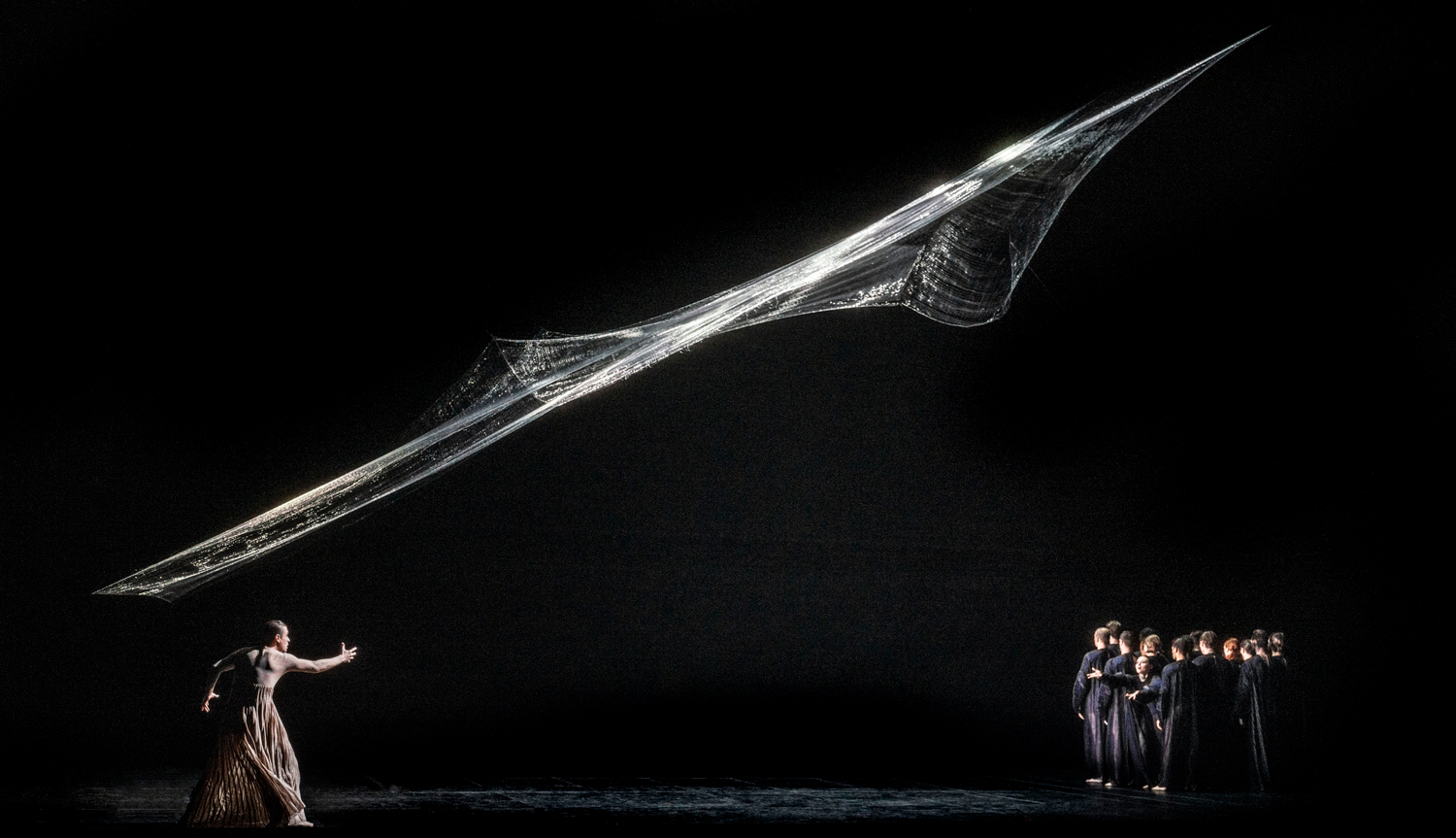The Amsterdam-based art collective Studio Drift creates objects that address what it is like to live in a world rapidly being transformed by technology in ways that are at once terrifying and beautiful. The future-focused practice, founded in 2007 by Ralph Nauta and Lonneke Gordijn, has devised bewildering interactive experiences, like a chorus of kinetic chandeliers that mimic the movements of blossoming flowers and an autonomous swarm of hundreds of illuminated drones that have taken flight at Burning Man and Art Basel Miami Beach. “We want to make people aware of their own nature, and take them on a journey inward,” Gordijn says. “I want people to wander around and interact with our work. You have to give people the freedom to experience that in their own way.”
At the Opera, Studio Drift’s Intricate Woven Sculpture Morphs With the Drama
The Dutch firm created the centerpiece for a new Dutch production of Monteverdi’s “L’Orfeo”: a computer-controlled nylon piece called “Ego.” “For me, it is a metaphor for life,” says the studio’s cofounder, Lonneke Gordijn.
By Tiffany Jow January 28, 2020
But Studio Drift’s latest project—the set for the Dutch National Touring Opera’s production of Italian composer Claudio Monteverdi’s 17th-century masterwork, L’Orfeo—isn’t for a mobile audience. The commission challenged the firm to design for a static audience, seated throughout a theater, and it responded with a shapeshifting sculpture—a 30-by-15-foot block made of fishing wire—that serves as a versatile soloist in its own right.
The opportunity came about after L’Orfeo’s director, Monique Wagemakers, saw Studio Drift’s 2018 solo exhibition at the Stedelijk Museum in Amsterdam, and rang its office to see if they would be interested in collaborating. Gordijn was immediately intrigued. “In our normal work, people have their own choices regarding how to interact with it. That’s very different from theater,” says Gordijn, who led the project on behalf of the studio. She agreed to do it on the condition that she was involved in the conceptual development of the show, which opened over the weekend at the Wilkminktheater in Enschede, the Netherlands, and will run in various locations in the country through February 22.

The plot of the opera, written in 1607 and based on the Greek legend of Orpheus, centers on Orfeo, a pessimist who has everything, including a beautiful fiancée and a knack for playing the lyre. On his wedding day, his wife, Eurydice, dies; Orfeo, abruptly cut off from marital bliss, refuses to accept this fate. He dives into the underworld to convince the gods to bring Eurydice back to life by hypnotizing them with his skillful string-playing. The gods agree to release her on one condition: as she follows him out of the underworld, Orfeo can’t look back at her; he has to trust that she’s there. Orfeo agrees. Of course, at some point during the journey home, he turns around—and Eurydice disappears forever. After losing her twice, Orfeo finds his life unbearable, and his father, Apollo, takes him to heaven, where he promises Orfeo will see Eurydice among the stars.
To create the set, Gordijn thought about the opera in a contemporary context. Its most timeless aspect, she decided, is Orfeo’s ever-evolving emotions. “When everything around him collapses, he becomes super strong and goes against his nature. That’s the start of enlightenment,” she says. “I wanted to express his perspective: it’s limited for a long time, then it changes completely, giving him his freedom and also vulnerabilities.”

Gordijn concocted a massive geometric form, called Ego, to personify Orfeo’s emotions. It was made by hand in the studio’s workshop using thin nylon wire. One side took four staffers an entire week to weave. (Studio Drift tried to find a collaborator to manufacture it, but no one had a large enough loom; ultimately, they built one themselves.) Onstage, Ego initially appears as a rigid, transparent block, housing Orfeo inside and symbolizing his limited way of seeing the world. Strategic lighting makes Ego appear transparent or solid. As the opera continues, Ego begins to shift in tandem with Orfeo’s emotions and actions: it starts to tilt, morphing into strange, unthinkable shapes from a curtain-like droop to what looks like a spider web being pulled diagonally from a single silk thread. In the second act, Ego becomes a boat that Orfeo rides across a river, into the underworld.
Eight motors, attached to each corner of the block, facilitate Ego’s transformations. Linked to a computer equipped with an algorithm and software program developed by Studio Drift, they change the corners’ position according to pre-set choreography. To ensure Ego moves exactly with the live music, the sculpture’s gestures can be prolonged or shortened on the spot by one of Studio Drift’s members via computer, offstage.

Though Ego takes on a wide array of forms during the opera, the full extent of its abilities aren’t actually seen. And so, during the Armory Show in New York in March, the Pace Gallery will present a slightly smaller version of the sculpture, which will be activated by live presentations by musicians including Lee Ranaldo of Sonic Youth. At the art fair, Ego will be experienced in the way Studio Drift’s work is typically consumed, with visitors interacting with it as they please.
On stage or in a white cube, Ego continues to fascinate Gordijn. “I see so many things in this block,” she says. “For me, it is a metaphor for life: for how we humans deal with nature, with ourselves, and how we get tangled up in our own thoughts.” She pauses, as if overcome by a wave of emotion. “Every day I look at it and I see another thing, or another aspect, in my life I can apply to it. I like that I can wander off in it.”
(Video by Jefta Varwijk)
